Spatial Trade-Offs and Temporal Evolution of Multiple Ecosystem Services in a Marine-Terrestrial Urban-Agglomeration Zone
Abstract
1. Introduction
2. Materials and Methods
2.1. Case Study and Data Sources
2.2. Methods
2.2.1. Land Use
2.2.2. Ecosystem Services Assessment
2.2.3. Ecosystem Services Trade-offs
3. Results
3.1. Impact of Urbanization on Regional Land Uses
3.1.1. Contemporary Urbanization Characteristics and Trends
3.1.2. Land Use Changes Influenced by Urbanization
3.2. Analysis of Spatial Trade-offs among Ecosystem Services
3.2.1. Spatial Tradeoff Analysis
3.2.2. Hotspot Analysis
3.3. Impacts of Changes in Increasing Areas of Construction Land on DT among Ecosystem Services
4. Discussion
4.1. Why such Trade-offs Occur between Ecosystem Services
4.2. Impact on Spatial Ecosystem Service Trade-offs
4.3. How to Reduce Acceleration in Ecosystem Service Trade-offs
4.4. Limitations
5. Conclusions
Author Contributions
Funding
Conflicts of Interest
Appendix A
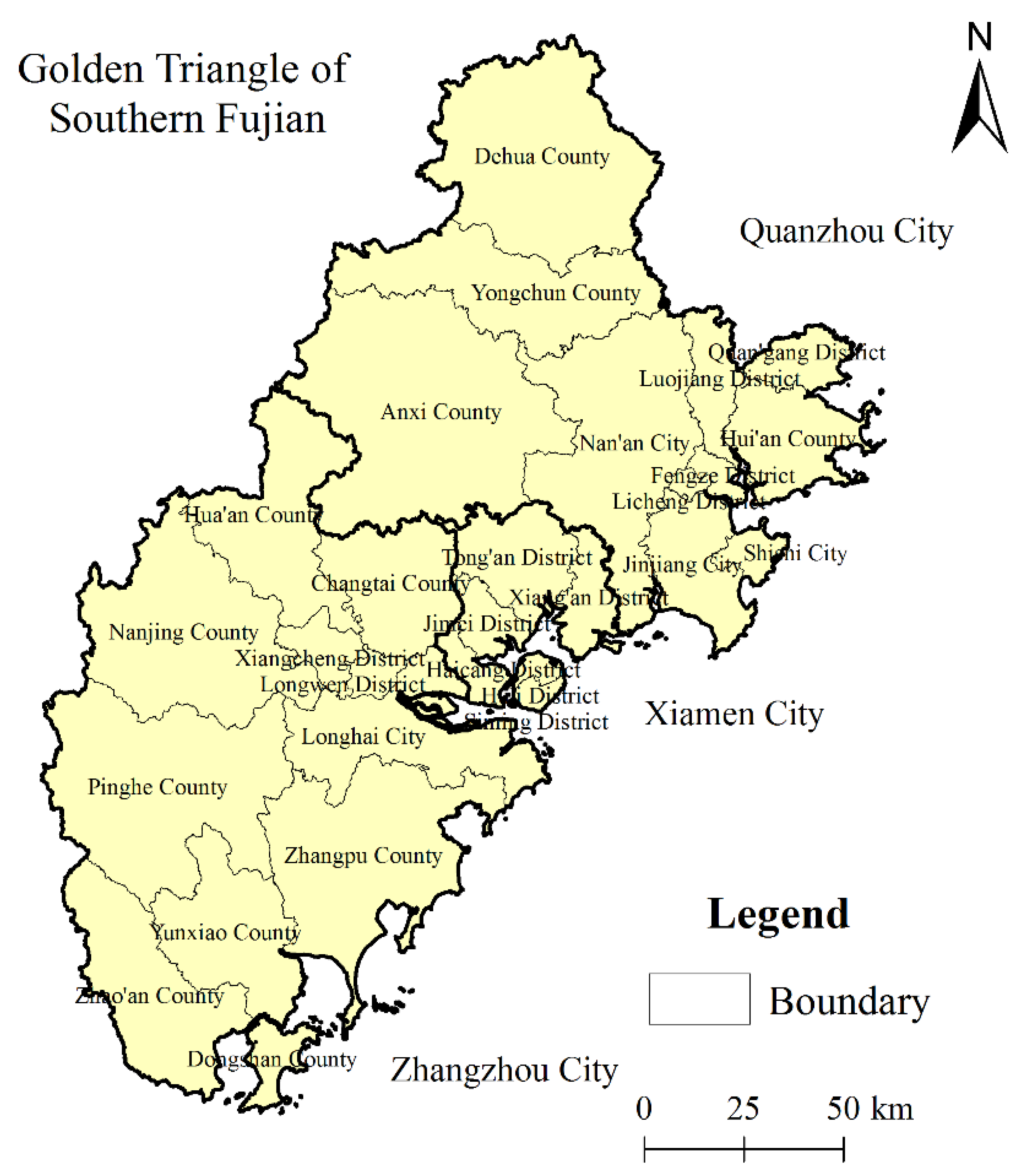
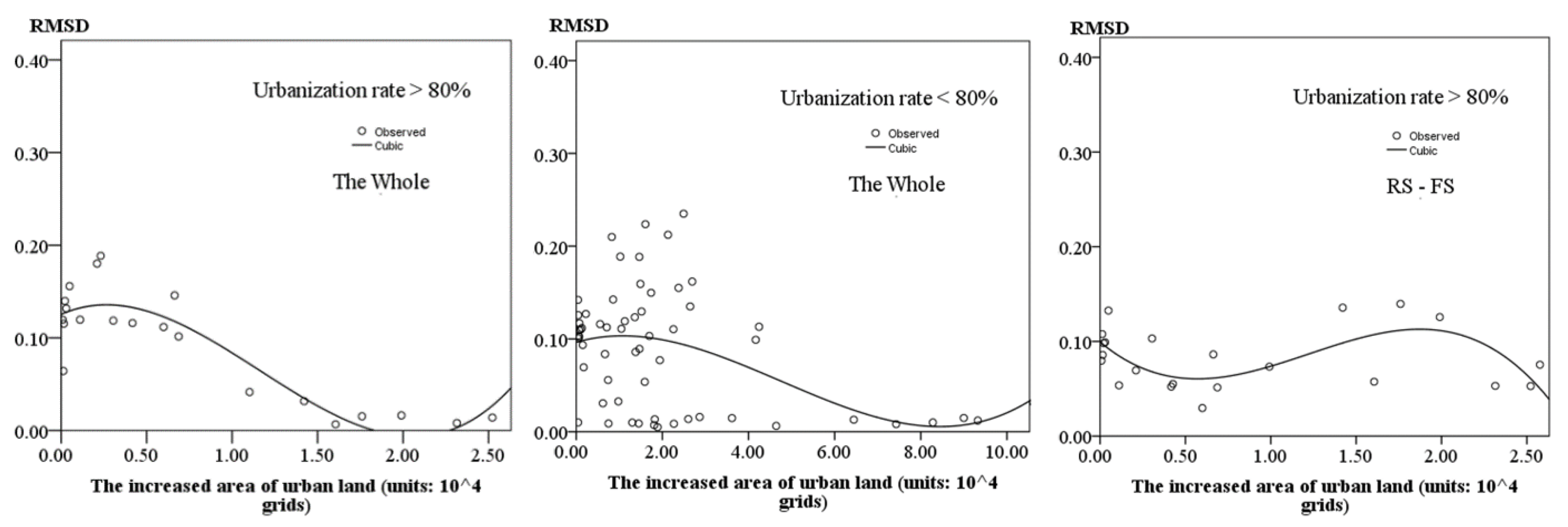
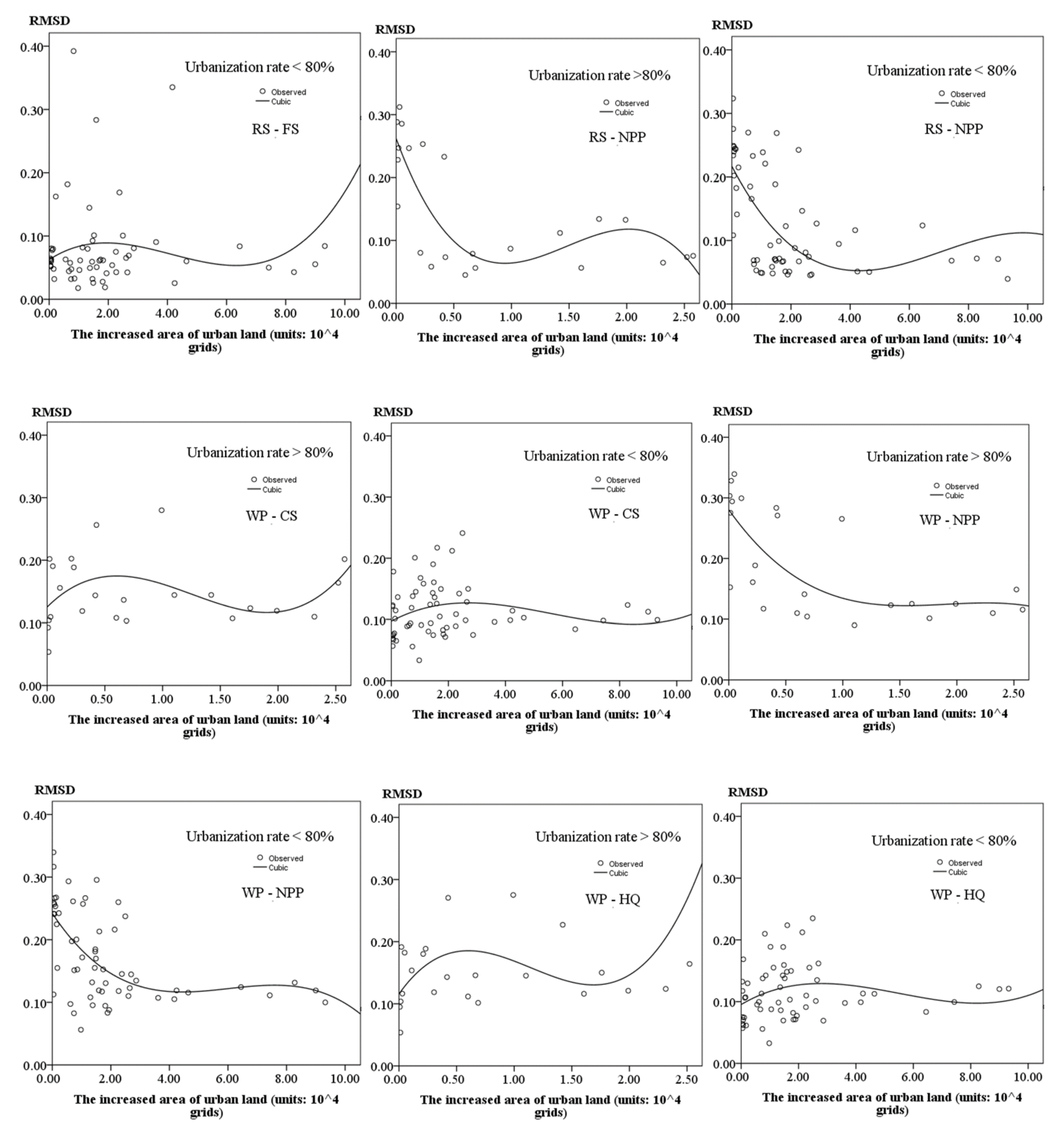
References
- Forman, R.T.T.; Godron, M. Landscape Ecology; John Wiley and Sons: New York, NY, USA, 1986. [Google Scholar]
- Xu, L.; Zhou, F.; Jiang, G.W.; Yu, C.X.; Wu, Y.H. Diversity of Summer Birds in Marine-terrestrial Interlaced Zone of Shankou District. Sichuan J. Zool. 2012, 31, 655–659. [Google Scholar] [CrossRef]
- Wang, Y.J.; Xie, B.G.; Su, W.C.; Wang, J.Y. Influence of Regional Pattern of Land Use Change on Ecosystem Services Value in East of Yuping County. Res. Soil Water Conserv. 2016, 23, 180–184. [Google Scholar] [CrossRef]
- Zhu, L.C.; Wang, H.W.; Tang, L.N. Importance Evaluation and Spatial Distribution Analysis of Ecosystem Services in Min Triangle area. Acta Ecol. Sin. 2018, 38, 7254–7268. [Google Scholar] [CrossRef]
- Daily, G.C. Nature’s Services: Societal Dependence on Natural Ecosystems; Island Press: Washington, DC, USA, 1997. [Google Scholar]
- Ouyang, Y.; Wang, R.S.; Zhao, J.Z. Ecosystem Services and Their Economic Valuation. Chin. J. Appl. Ecol. 1995, 10, 635–640. [Google Scholar] [CrossRef]
- Lautenbach, S.; Volk, M.; Gruber, B.; Dormann, C.F. Quantifying Ecosystem Service Trade-offs. In Proceedings of the 5th International Congress on Environmental Modelling and Software, Ottawa, ON, Canada, 5–8 July 2010; p. 417. Available online: htps://scholarsarchive.byu.edu/iemssconference/2010/all/417 (accessed on 5 May 2019).
- Shiwei, L.; Ruidong, W.; Feiling, Y.; Wang, J.; Wu, W. Spatial trade-offs and synergies among ecosystem services within a global biodiversity hotspot. Ecol. Indic. 2018, 84, 371–381. [Google Scholar]
- Rodríguez, J.P.; Beard, T.D., Jr.; Bennett, E.M.; Cumming, G.S.; Cork, S.J.; Agard, J.; Dobson, A.P.; Peterson, G.D. Trade-offs across space, time, and ecosystem services. Ecol. Soc. 2006, 11, 709–723. [Google Scholar]
- TEEB. The Economics of Ecosystems and Biodiversity: Ecological and Economics Foundations; Kumar, P., Ed.; Earthscan: London, UK; Washington, DC, USA, 2010. [Google Scholar]
- Lester, S.E.; Costello, C.; Halpern, B.S.; Gaines, S.D.; White, C.; Barth, J.A. Evaluating tradeoffs among ecosystem services to inform marine spatial planning. Mar. Policy 2013, 38, 80–89. [Google Scholar] [CrossRef]
- Wong, C.P.; Bo, J.; Kinzig, A.P.; Lee, K.N.; Ouyang, Z. Linking ecosystem characteristics to final ecosystem services for public policy. Ecol. Lett. 2015, 18, 108–118. [Google Scholar] [CrossRef]
- Zheng, H.; Wang, L.J.; Wu, T. Coordinating ecosystem service trade-offs to achieve win-win outcomes: A review of the approaches. J. Environ. Sci. 2019, 82, 103–112. [Google Scholar] [CrossRef]
- Nan, L.; Fu, B.J.; Jin, T.; Chang, R. Trade-off analyses of multiple ecosystem services by plantations along a precipitation gradient across Loess Plateau landscapes. Landsc. Ecol. 2014, 29, 1697–1708. [Google Scholar] [CrossRef]
- Zhou, Z.X.; Li, J.; Guo, Z.Z.; Li, T. Trade-offs between carbon, water, soil and food in Guanzhong-Tianshui economic region from remotely sensed data. Int. J. Appl. Earth Obs. Geoinf. 2017, 58, 145–156. [Google Scholar] [CrossRef]
- Wang, B.; Zhao, J.; Hu, X. Analysis on Trade-offs and Synergistic Relationships among Multiple Ecosystem Services in the Shiyang River Basin. Acta Ecol. Sin. 2018, 38, 7582–7595. [Google Scholar] [CrossRef]
- Dai, E.F.; Wang, Y.H.; Ma, L.; Li, S.C.; Zhang, H.Q.; Xin, L.J.; Xu, E.Q.; Gao, J.B.; Zhu, L.Q.; Wang, Y.K. Land Use Change and its Ecological Effects in Typical Mountainous Areas in China. Chin. J. Nat. 2018, 40, 33–40. [Google Scholar] [CrossRef]
- Wu, Y.; Tao, Y.; Yang, G.S.; Ou, W.; Pueppke, S.; Sun, X.; Chen, G.; Tao, Q. Impact of land use change on multiple ecosystem services in the rapidly urbanizing Kunshan City of China: Past trajectories and future projections. Land Use Policy 2019, 85, 419–427. [Google Scholar] [CrossRef]
- Liu, W.; Zhan, J.Y.; Fen, Z.; Yan, H.; Zhang, F.; Wei, X. Impacts of urbanization-induced land-use changes on ecosystem services: Acase study of the Pearl River Delta Metropolitan Region, China. Ecol. Indic. 2019, 98, 228–238. [Google Scholar] [CrossRef]
- Ma, S.; Duggan, J.M.; Eichelberger, B.A.; McNally, B.W.; Foster, J.R.; Pepi, E.; Conte, M.N.; Daily, G.C.; Ziv, G. Valuation of ecosystem services to inform management of multiple-use landscapes. Ecosyst. Serv. 2016, 19, 6–18. [Google Scholar] [CrossRef]
- Zhang, Y.N.; Long, H.L.; Tu, S.S.; Ge, D.Z.; Ma, L.; Wang, L.Z. Spatial identification of land use functions and their tradeoffs/synergies in China: Implications for sustainable land management. Ecol. Indic. 2019, 107, 105550. [Google Scholar] [CrossRef]
- Gong, J.; Liu, D.Q.; Zhang, J.X.; Xie, Y.C.; Cao, E.J.; Li, H.Y. Tradeoffs/synergies of multiple ecosystem services based on land use simulation in a mountain-basin area, western China. Ecol. Indic. 2019, 99, 283–293. [Google Scholar] [CrossRef]
- Zheng, H.; Li, Y.F.; Ouyang, Z.Y.; Luo, Y.C. Progress and Perspectives of Ecosystem Services Management. Acta Ecol. Sin. 2013, 33, 702–710. [Google Scholar] [CrossRef]
- Xu, J.Y.; Liu, X.; Feng, L.; Huan, Y.T. Research Advances in Understanding the Trade-offs Involved in Payment for Ecosystem Services. Acta Ecol. Sin. 2015, 35, 6901–6907. [Google Scholar] [CrossRef]
- Lin, L.Z. New Quanzhou Studies in the Context of “One Belt and One Road”. In Proceedings of the Application and Innovation of Local Science Symposium Proceedings, Ordos, China, 16 September 2015. [Google Scholar]
- Liu, X.; Ding, Z.C.; Yang, Y.X. Strategies Towards a Metropolitan Area with Strong MICE Industry in Golden Triangle. J. Xiamen Univ. Technol. 2016, 24, 34–40. [Google Scholar] [CrossRef]
- Fujian Provincial Bureau of Statistics, Fujian Survey Team of National Bureau of Statistics. Fujian Statistical Yearbook 2016; China Statistical Press: Beijing, China, 2016.
- Wang, S.Y.; Liu, J.Y.; Zhang, Z.X.; Zhou, Q.B.; Zhao, X.L. Analysis on Spatial-Temporal Features of Land Use in China. Acta Geogr. Sin. 2001, 56, 631–639. [Google Scholar]
- Chen, W.X.; Li, J.F.; Jiang, W.; Zhu, L.J.; Xiong, J.H.; School of Public Administration, China University of Geosciences. Impacts of Land Use Change on Ecosystem Service Values Based on RS and GIS in Western Mountainous Area of He’nan Province. Res. Soil Water Conserv. 2018, 25, 377–381. [Google Scholar] [CrossRef]
- Elena, M.B.; Garry, D.P.; Line, J.G. Understanding relationships among multiple ecosystem services. Ecol. Lett. 2009, 12, 1394–1404. [Google Scholar] [CrossRef]
- Cao, X.L.; Liu, G.H.; Zhang, Y.; Li, X.S. Willingness-to-pay for Recreation Services of Urban Ecosystem and its Value Assessment: A Case Study in the Wenjiang District of Chengdu City, China. Acta Ecol. Sin. 2017, 37, 2970–2981. [Google Scholar] [CrossRef]
- Cui, L.L.; Du, H.Q.; Shi, J.; Chen, Z.; Guo, W. Spatial and Temporal Pattern of Vegetation NPP and Its Relationship with Climate in the Southeastern China. Sci. Geogr. Sin. 2016, 36, 787–793. [Google Scholar] [CrossRef]
- Chen, L.J.; Liu, G.H.; Feng, X.F. Advances in Study on Net Primary Productivity of Vegetation Using Remote Sensing. Chin. J. Ecol. 2002, 21, 53–57. [Google Scholar] [CrossRef]
- General Office of the State Council of the People’s Republic of China. Program for the Development of Food and Nutrition in China (2014–2020). (000014349/2014-00010); General Office of the State Council of the People’s Republic of China: Beijing, China, 2014.
- Wang, B.S.; Chen, H.X.; Dong, Z.; Zhu, W.; Qiu, Q.Y.; Tang, L.N. Impact of land use change on the water conservation service of ecosystems in the urban agglomeration of the Golden Triangle of Southern Fujian, China, in 2030. Acta Ecol. Sin. 2020, 40. [Google Scholar] [CrossRef]
- Costanza, R.; d’ Arge, R.; de Groot, R.; Farberk, S.; Grasso, M.; Hannon, B.; Limburg, K.E.; Naeem, S.; O’neill, R.V.; Paruelo, J.; et al. The value of the world’ s ecosystem services and natural capital. Nature 1997, 387, 253–260. [Google Scholar] [CrossRef]
- Xie, G.D.; Zhen, L.; Lu, C.X.; Xiao, Y.; Chen, C. Expert Knowledge Based Valuation Method of Ecosystem Services in China. J. Nat. Resour. 2008, 23, 911–919. [Google Scholar]
- Bradford, J.B.; D’Amato, A.W. Recognizing trade-offs in multi-objective land management. Front. Ecol. Environ. 2012, 10, 210–216. [Google Scholar] [CrossRef]
- Fu, B.J.; Yu, D. Trade-off Analyses and Synthetic Integrated Method of Multiple Ecosystem Services. Resour. Sci. 2016, 38, 1–9. [Google Scholar] [CrossRef]
- Salvati, L.; Carlucci, M. The economic and environmental performances of rural districts in Italy: Are competitiveness and sustainability compatible targets? Ecol. Econ. 2011, 70, 2446–2453. [Google Scholar] [CrossRef]
- Chen, H.; Tang, L.; Qiu, Q.; Wu, T.; Wang, Z.; Xu, S.; Xiao, L. Coupling between Rural Development and Ecosystem Services, the Case of Fujian Province, China. Sustainability 2018, 10, 524. [Google Scholar] [CrossRef]
- Wu, D.; Li, C.; Chen, L. Principles and Application of Synergetics; Huazhong University of Science and Technology Press: Wuhan, China, 1990; pp. 9–17. [Google Scholar]
- Liu, D.; Yang, Y. Coupling coordinative degree of regional economy-tourism-ecological environment: A case study of Anhui province. Resour. Environ. Yangtze Basin 2011, 20, 892–896. [Google Scholar]
- Ma, L.; Jin, F.J.; Liu, Y. Spatial Pattern and Industrial Sector Structure Analysis on the Coupling and Coordinating Degree of Regional Economic Development and Environmental Pollution in China. Acta Geogr. Sin. 2012, 67, 1299–1307. [Google Scholar]
- Xiong, J.X.; Chen, D.L.; Peng, B.F.; Deng, S.T.; Xie, X.M. Spatial-temporal Difference of Coupling Coordinative Degree of Ecological Carrying Capacity in the Dongting Lake Region. Sci. Geogr. Sin. 2014, 34, 1108–1116. [Google Scholar] [CrossRef]
- Wang, Y.N.; Yang, H.F.; Shui, W. Accounting of Ecosystem Services Value and Trade-off and Synergy Relationship in Fujian Delta Urban Agglomeration. In Proceedings of the Symposium Proceedings of the 2018 China land Resources Scientific Innovation and Development, Nanjing, China, 20 April 2018; pp. 319–329. [Google Scholar]
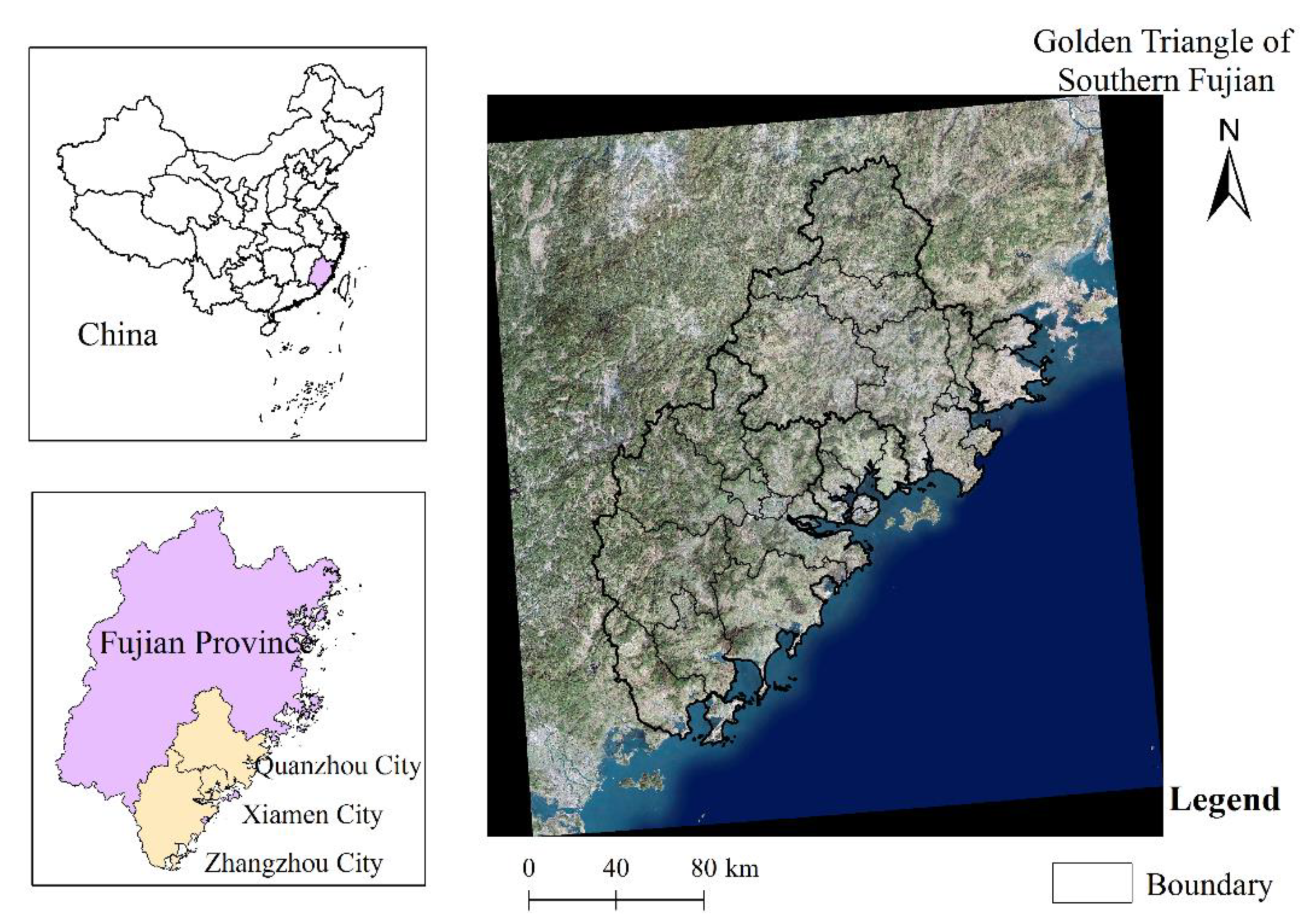
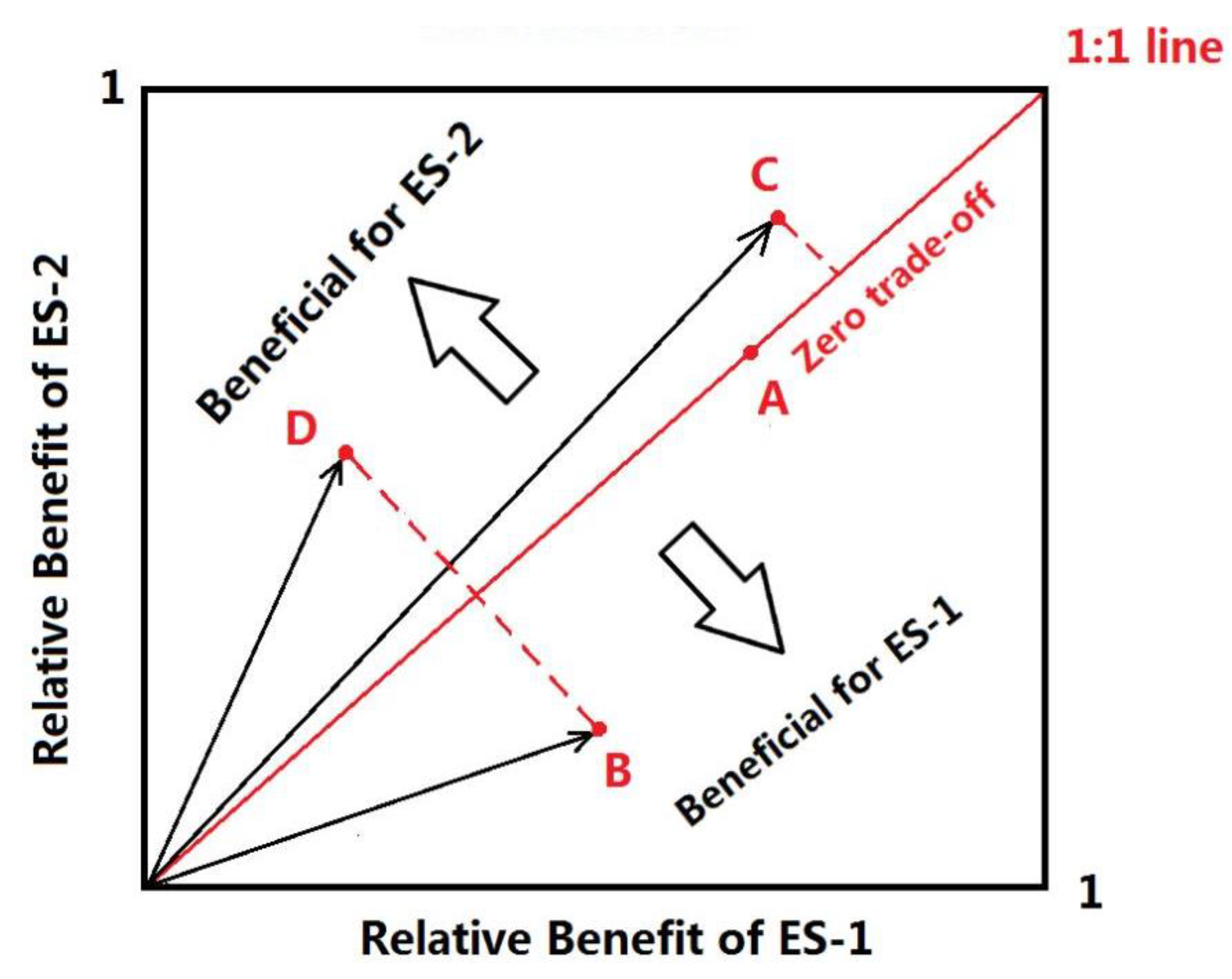
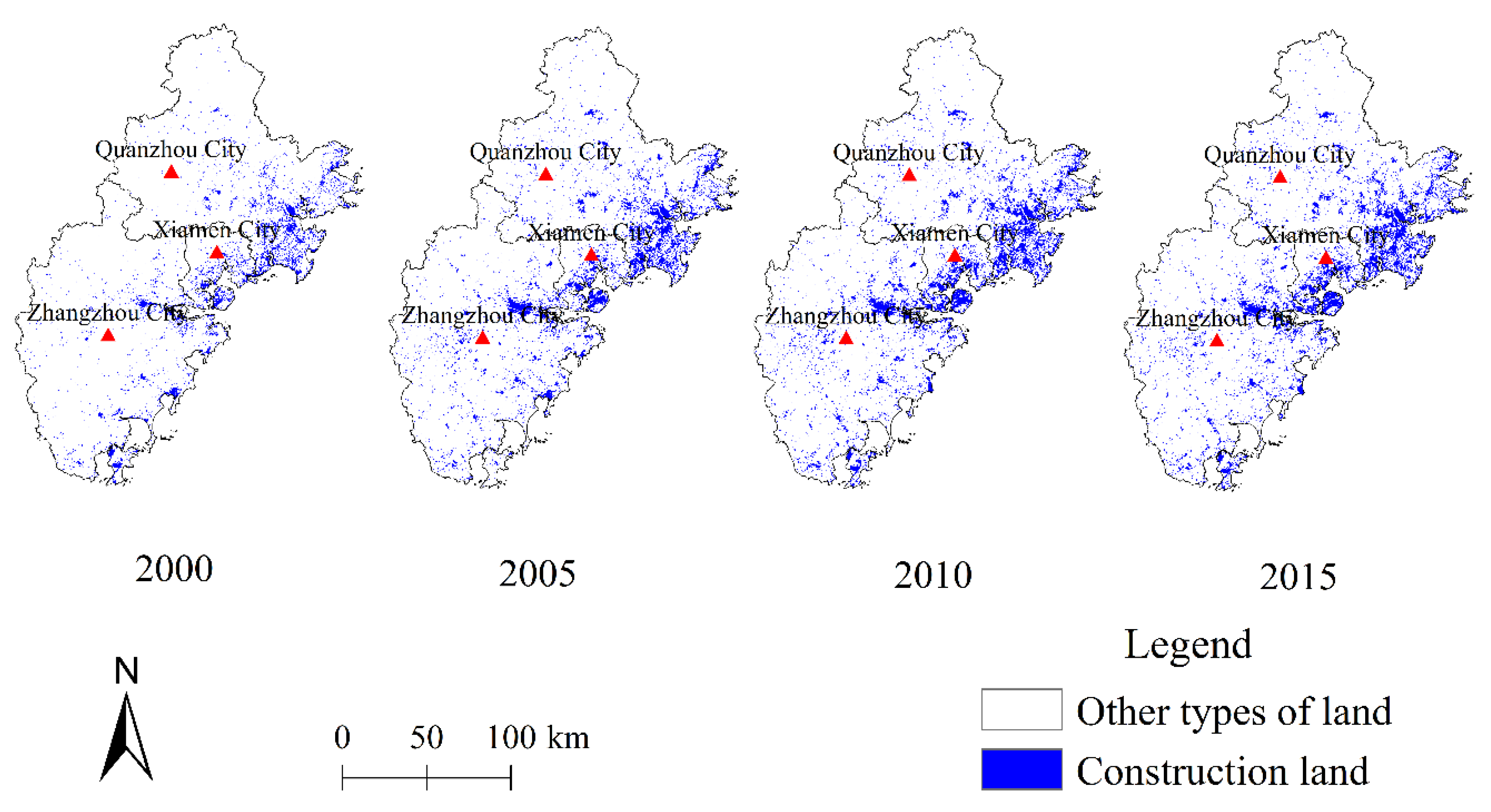
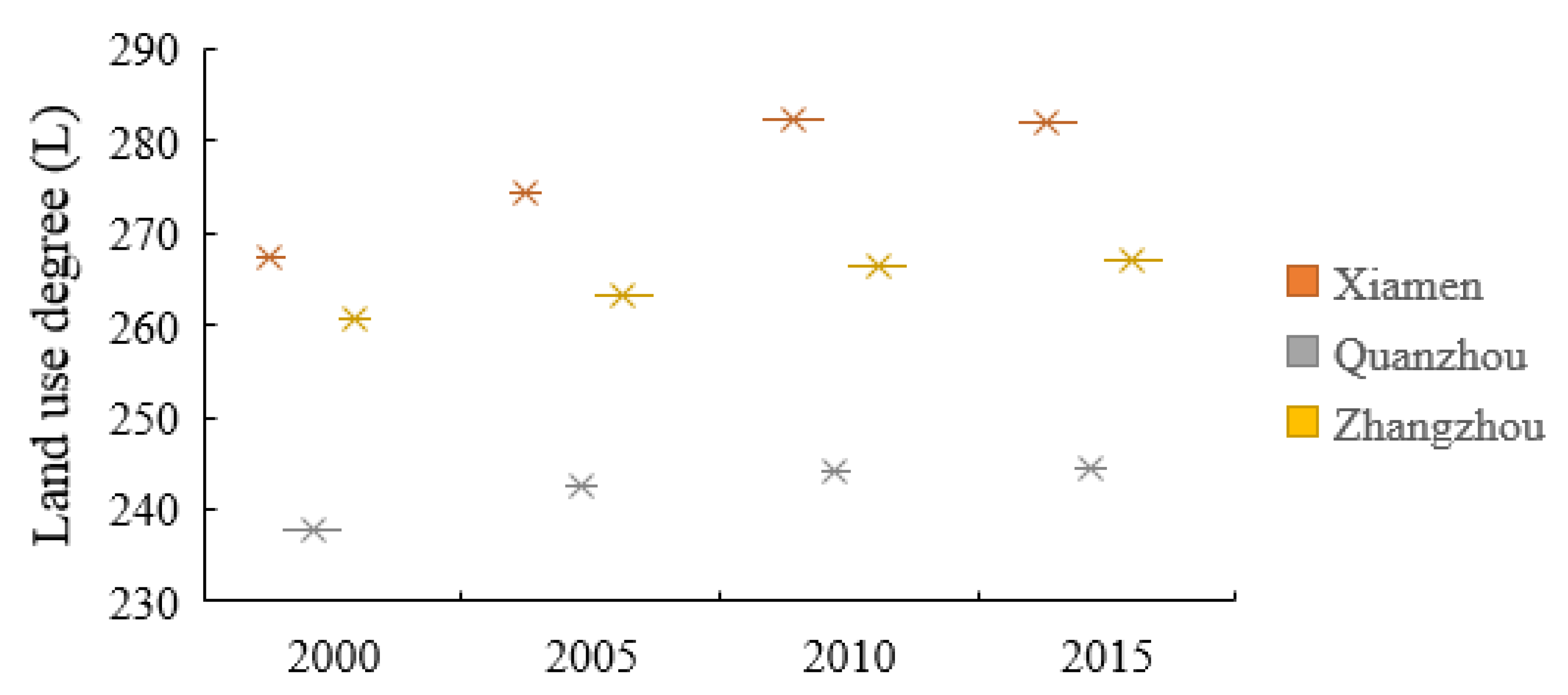
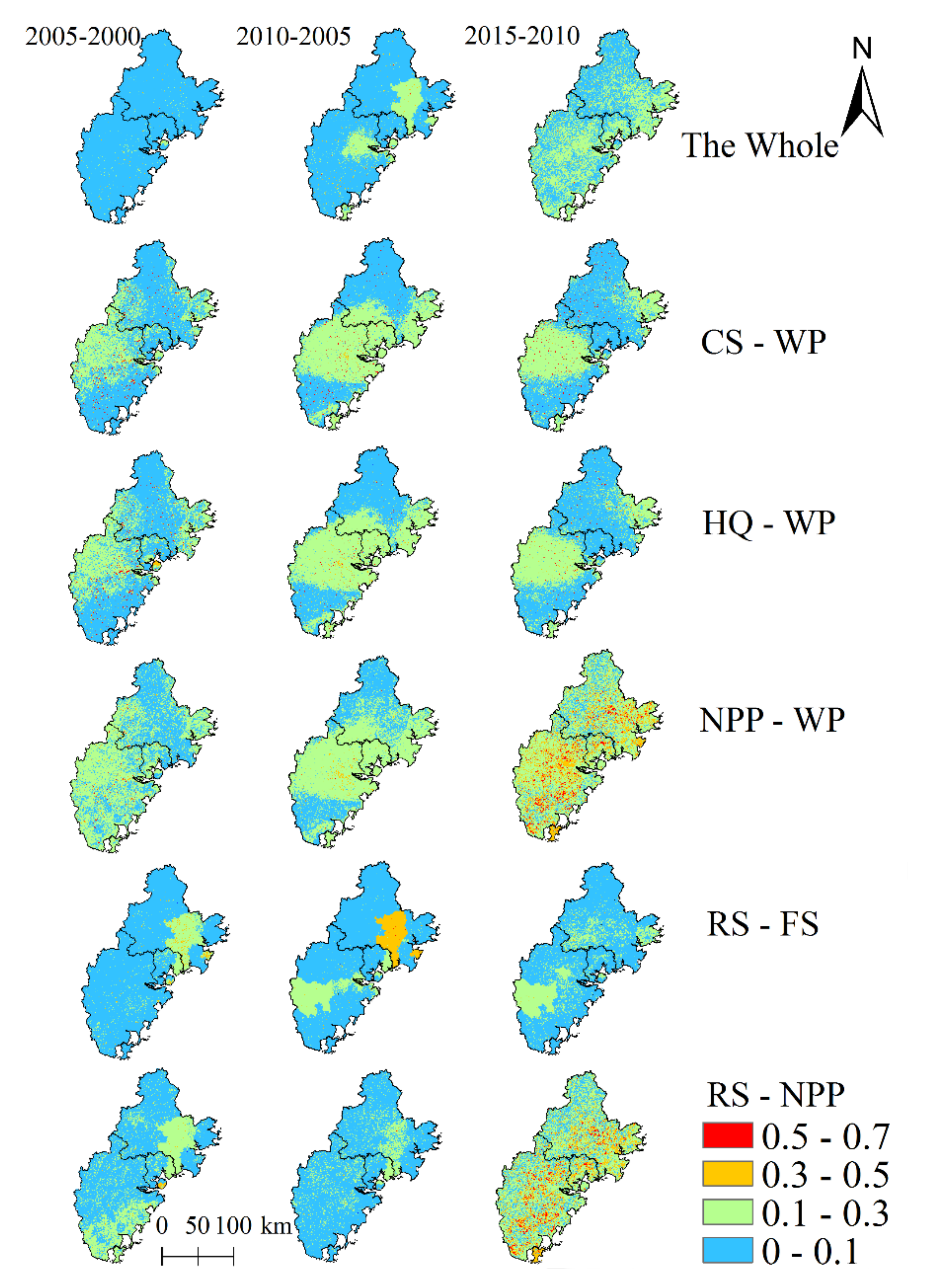
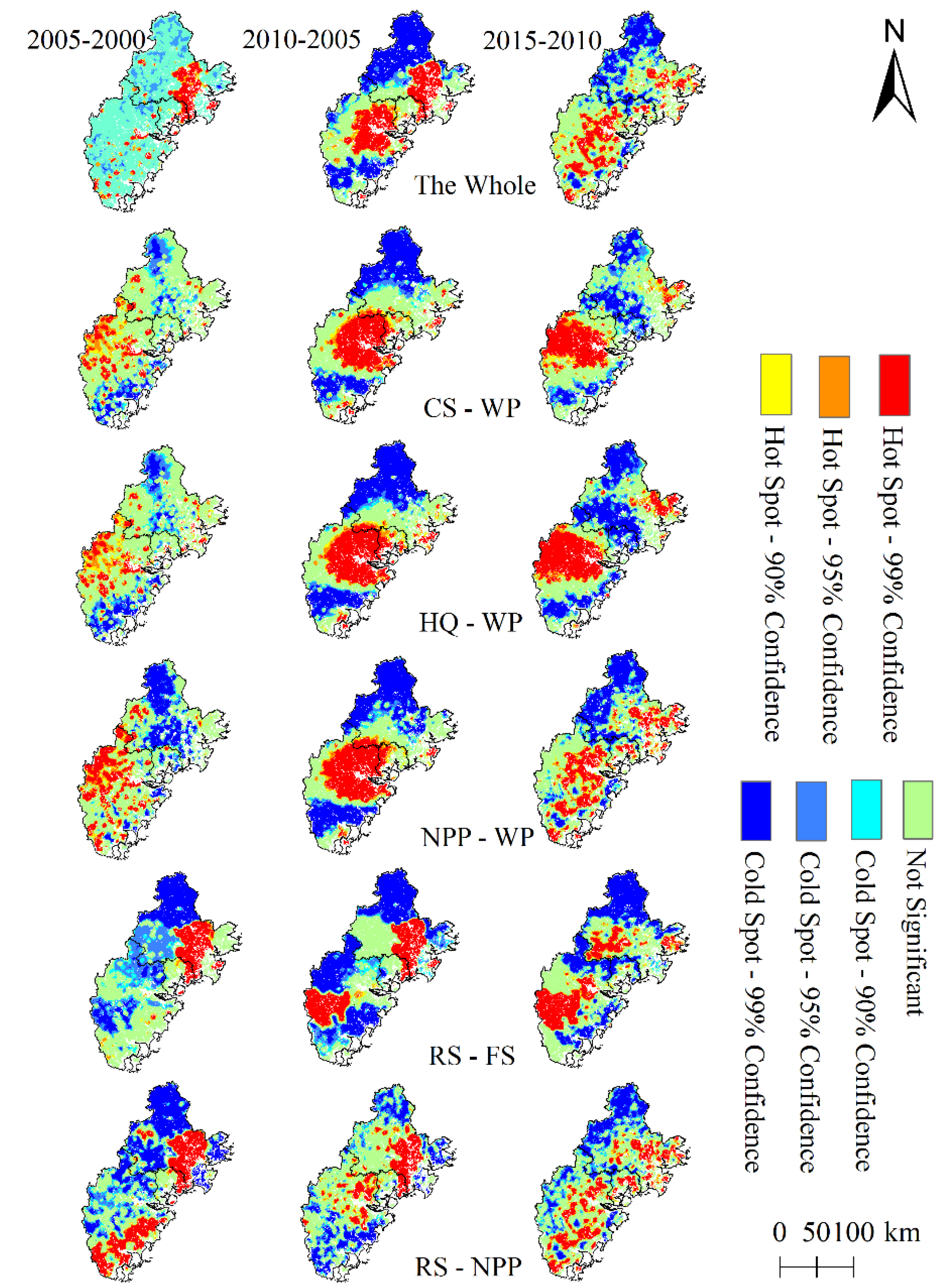
| Data Category | Description | Sources |
|---|---|---|
| Statistical data | Data about the Gross Domestic Product (GDP), Population, Crop production. | Fujian Statistical Yearbook (2001, 2006, 2011, 2016) |
| Land use and land cover data NPP data | 1-Cultivated land, 2-forestland, 3-grassland, 4-water area, 5-construction land, 6- unused land The net primary productivity data | Resource and Environment Data Cloud Platform, China (http://www.resdc.cn/Default.aspx) |
| Weather data | Data about the temperature, precipitation. | National Meteorological Information Center, China (http://data.cma.cn/) |
| Soil data | Data about the soil depth, soil sand content (%), soil silt content (%). soil clay content (%), organic carbon (%), and soil bulk density (g/cm3) | World Soil Database _ China soil Dataset |
| DEM data | Data about the slope, elevation. | Geospatial Data Cloud of China (http://www.gscloud.cn/) |
| Other data | Data about the soil saturated hydraulic conductivity (cm/d), flow coefficient V. | All from others’ research (shown in the Methods section) |
| Types | Level of Unused Land | Level of Grassland, Forested Land, and Water Areas | Level of Agricultural Land | Level of Construction Land |
|---|---|---|---|---|
| Index of classification | 1 | 2 | 3 | 4 |
| Indicator | Method | Description |
|---|---|---|
| Habitat quality (HQ) | From the Integrated Valuation of Ecosystem Services and Tradeoffs model, InVEST. (https://naturalcapitalproject.stanford.edu/software/invest) | is habitat quality in grid , is the level of threat in grid , is a half-saturation constant, which usually equates to half of the maximum value of , is the habitat suitability of the th land use and land cover, and is a normalized constant, which is usually taken as 2.5. |
| Net primary productivity (NPP) | Resource and Environment Data Cloud Platform, China (http://www.resdc.cn/Default.aspx) | |
| Water provision (WP) | From the Integrated Valuation of Ecosystem Services and Tradeoffs model, InVEST. (https://naturalcapitalproject.stanford.edu/software/invest) | is average annual water provision in grid , is average annual precipitation in grid , is average annual evaporation in grid of the th land use and land cover type. |
| Food supply (FS) | According to China’s Food and Nutrition Development (2014–2020) [34], annual per capita food consumption in China in 2020 will be 135 kg (12 kg edible vegetable oil, 13 kg beans, 29 kg meat, 16 kg eggs, 36 kg milk, 18 kg aquatic products, 140 kg vegetables, and 60 kg fruit) | We can determine the number of people that can be supplied with food in each county according to China’s Food and Nutrition Development (2014–2020). |
| Carbon storage (CS) | From the Integrated Valuation of Ecosystem Services and Tradeoffs model, InVEST. (https://naturalcapitalproject.stanford.edu/software/invest) | is total carbon storage, is carbon storage above ground, is carbon storage below ground, is soil organic carbon stock, is dead (litter) organic carbon stock. |
| Water retention (WR) (Quantitatively, the residence time of water is calculated per grid unit based on water production data, topographic index data, soil saturated hydraulic conductivity data, flow coefficient data, and so on) | See Wang [35]. | is the amount of water retention (mm), is a flow coefficient which can be derived from the literature [35], is the topographic index which can be calculated through DEM, is soil saturated hydraulic conductivity (cm/d), and is average annual water provision in grid . is the number of watershed cells in a watershed unit, is soil depth, and is the percentage of slope. denotes soil sand content (%), is soil silt content (%). is soil clay content (%), is the distribution of soil organic matter which can be replaced by organic carbon (%), and is soil bulk density (g/cm3). |
| Recreation services values (RS) | Based on the results of Cao [33], we use a correction coefficient to estimate the willingness to pay for recreation services in the study area. | |
| Landscape aesthetic values (LA) | Based on the results of Costanza [36] and Xie [37], we apply a correction coefficient to estimate the aesthetic value of ecosystem services in the study area. |
| Degree of Synergy | Range | Degree of Tradeoff | |
|---|---|---|---|
| [0, 0.1] | Weak | [−0.1, 0] | Weak |
| [0.1, 0.3] | Low Moderate | [−0.3, −0.1] | Low Moderate |
| [0.3, 0.5] | Moderate | [−0.5, −0.3] | Moderate |
| [0.5, 0.7] | Strong | [−0.7, −0.5] | Strong |
| [0.7, 0.9] | Very Strong | [−0.9, −0.7] | Very Strong |
| 2000 | Agricultural Land | Forested Land | Grassland | Water area | Construction Land | Unused Land | Total | |
|---|---|---|---|---|---|---|---|---|
| 2015 | ||||||||
| Agricultural land | 537,354 | 10,425 | 3405 | 576 | 2710 | 19 | 554,489 | |
| Forested land | 10,443 | 1,224,706 | 12,555 | 397 | 986 | 47 | 1,249,134 | |
| Grassland | 3985 | 13,768 | 376,367 | 129 | 420 | 149 | 394,818 | |
| Water area | 4470 | 1762 | 552 | 35,163 | 8964 | 26 | 50,937 | |
| Construction land | 80,363 | 33,567 | 14,439 | 4336 | 114,420 | 55 | 247,180 | |
| Unused land | 27 | 82 | 169 | 109 | 3 | 1964 | 2354 | |
| Total | 636,642 | 1,284,310 | 407,487 | 40,710 | 127,503 | 2260 | 2,498,912 | |
| 2015–2000 | 2015–2010 | 2010–2005 | 2005–2000 | |||||||||||||
|---|---|---|---|---|---|---|---|---|---|---|---|---|---|---|---|---|
| Whole Region | Xia-men | Quan-zhou | Zhang-zhou | Whole Region | Xia-men | Quan-zhou | Zhang-zhou | Whole Region | Xia-men | Quan-zhou | Zhang-zhou | Whole Region | Xia-men | Quan-zhou | Zhang-zhou | |
| Agricultural land | −0.86 | 1.60 | −0.93 | −0.63 | −0.22 | 0.04 | 0.36 | 0.11 | 0.88 | 1.97 | 0.71 | 0.82 | 1.58 | 3.12 | 1.81 | 1.00 |
| Forested land | 0.18 | 0.17 | −0.15 | 0.21 | 0.00 | 0.02 | 0.01 | 0.00 | 0.15 | 0.15 | 0.13 | 0.16 | 0.41 | 0.39 | 0.32 | 0.48 |
| Grasslands | −0.21 | 0.20 | −0.21 | −0.20 | 0.00 | 0.04 | 0.00 | 0.01 | −0.08 | 0.11 | 0.00 | −0.13 | −0.55 | 0.53 | −0.63 | −0.49 |
| Water areas | 2.11 | 1.30 | 1.29 | 4.14 | 1.39 | 0.25 | 1.64 | 1.29 | 4.13 | 1.97 | 1.56 | 7.82 | 0.41 | 3.18 | 0.45 | 1.88 |
| Construction land | 6.27 | 6.44 | 5.76 | 6.96 | 0.45 | 0.13 | 0.63 | 0.35 | 4.32 | 6.98 | 2.89 | 5.33 | 11.21 | 8.98 | 11.56 | 11.71 |
| Unused land | 1.15 | 0.75 | 35.28 | −0.02 | −0.02 | −0.02 | 3.09 | 2.72 | 147.31 | 0.32 | −0.38 | −4.95 | ||||
| WP | WR | RS | NPP | LA | HQ | FS | CS | |
|---|---|---|---|---|---|---|---|---|
| WP | 1.00 | −0.01 | 0.12 | −0.22 | 0.01 | −0.52 | −0.05 | −0.43 |
| WR | 1.00 | 0.02 | −0.02 | 0.03 | 0.02 | 0.01 | 0.02 | |
| RS | 1.00 | −0.19 | 0.03 | −0.02 | −0.54 | −0.01 | ||
| NPP | 1.00 | −0.06 | 0.03 | 0.06 | 0.02 | |||
| LA | 1.00 | 0.08 | −0.05 | 0.05 | ||||
| HQ | 1.00 | 0.00 | 0.80 | |||||
| FS | 1.00 | 0.00 | ||||||
| CS | 1.00 |
| 2000–2005 | 2005–2010 | 2010–2015 | |
|---|---|---|---|
| All Ecosystem Services | 0.49 | 0.49 | 0.48 |
| RS-FS | 0.50 | 0.50 | 0.50 |
| RS-NPP | 0.50 | 0.49 | 0.48 |
| WP-CS | 0.50 | 0.50 | 0.49 |
| WP-NPP | 0.50 | 0.50 | 0.45 |
| WP-HQ | 0.49 | 0.49 | 0.49 |
© 2020 by the authors. Licensee MDPI, Basel, Switzerland. This article is an open access article distributed under the terms and conditions of the Creative Commons Attribution (CC BY) license (http://creativecommons.org/licenses/by/4.0/).
Share and Cite
Chen, H.; Tang, L.; Qiu, Q.; Wang, B.; Hu, W. Spatial Trade-Offs and Temporal Evolution of Multiple Ecosystem Services in a Marine-Terrestrial Urban-Agglomeration Zone. Int. J. Environ. Res. Public Health 2020, 17, 1231. https://doi.org/10.3390/ijerph17041231
Chen H, Tang L, Qiu Q, Wang B, Hu W. Spatial Trade-Offs and Temporal Evolution of Multiple Ecosystem Services in a Marine-Terrestrial Urban-Agglomeration Zone. International Journal of Environmental Research and Public Health. 2020; 17(4):1231. https://doi.org/10.3390/ijerph17041231
Chicago/Turabian StyleChen, Huaxiang, Lina Tang, Quanyi Qiu, Baosheng Wang, and Weixiang Hu. 2020. "Spatial Trade-Offs and Temporal Evolution of Multiple Ecosystem Services in a Marine-Terrestrial Urban-Agglomeration Zone" International Journal of Environmental Research and Public Health 17, no. 4: 1231. https://doi.org/10.3390/ijerph17041231
APA StyleChen, H., Tang, L., Qiu, Q., Wang, B., & Hu, W. (2020). Spatial Trade-Offs and Temporal Evolution of Multiple Ecosystem Services in a Marine-Terrestrial Urban-Agglomeration Zone. International Journal of Environmental Research and Public Health, 17(4), 1231. https://doi.org/10.3390/ijerph17041231






